Series
Economic Geology Models 1.
Geochemical Exploration and Metallogenic Studies, Northern Chile
Eion M. CameronEion Cameron Geochemical Inc.
865 Spruce Ridge Road
Carp, ON, Canada, K0A 1L0
eioncam@gmail.com
Matthew I. Leybourne
Ocean Exploration
GNS Science
Lower Hutt, New Zealand
Carlos Palacios
Departamento de Geología
Facultad de Ciencias Físicas y Matemáticas Universidad de Chile
Santiago, Chile
Martin Reich
Departamento de Geología
Facultad de Ciencias Físicas y Matemáticas Universidad de Chile
Santiago, Chile
Submitted February, 2008. Accepted as revised December, 2008
SUMMARY
Research was initiated in 1998 on geo-chemical methods of exploration for copper porphyry deposits buried under thick, lithified piedmont gravel cover in the Atacama Desert, Chile. Early data suggest that mineralized, saline groundwater has been episodically forced up through fracture zones to the surface during earthquakes, creating geochemical anomalies above ore deposits. Follow-up research supported by the Canadian Mining Industry Research Organization (CAMIRO) examined the composition of both groundwater and surface anomalies, confirming a link between the two. Further work suggests that the geo-chemical anomalies are the surface expression of a process common to the metallogenic evolution of many deposits. Porphyry intrusion and hypo-gene mineralization are controlled by faults, and are followed by supergene enrichment in a semi-arid climate. After burial by Miocene gravels, the climate changed to hyper-arid; estimates of the onset of hyperaridity vary from mid-Miocene (11–14 Ma) to Pliocene (~3–5 Ma). Since then, saline dewatering of the basement along long-lived faults has converted the original super-gene copper oxide assemblage, formed in equilibrium with meteoric water and lacking atacamite, to one containing atacamite [Cu2Cl(OH)3], the copper mineral especially associated with northern Chile. This interpretation is supported by studies showing that the salinity of fluid inclusions in atacamite is similar to that of local groundwater and that atacamite is considerably younger than the co-existing supergene alteration.SOMMAIRE
La recherche décrite ici et initiée en 1998 visait à mettre au point des méth-odes d'exploration de gisements de porphyres cuprifères enfouis sous d'épaisses couches lithifiées de graviers dans le désert d'Atacama au Chili. Des données préliminaires indiquent que des eaux souterraines salines minéralisées ont été poussées épisodiquement jusqu'à la surface, à travers des zones de fractures, à l'occasion de séismes, créant ainsi des anomalies au-dessus de gisements minéraux. Une recherche subséquente appuyée par la Canadian Mining Industry Research Organization (CAMIRO) qui a porté sur la composition de l'eau souterraine et des anomalies de surface, a permis de confirmer l'existence d'un lien entre les deux. Les résultats de travaux subséquents permettent de croire que ces anomalies géochimiques sont l'expression en surface d'un processus commun à l'évolution métallogénique de nombreux gisements. L'intrusion porphyrique et la minéralisation hypogène sont tributaires de failles, auxquelles s'est ensuite ajouté un enrichissement supergène sous climat semi-aride. Après l'enfouissement au Miocène par des graviers, le climat est devenu hyper-aride; selon les estimations le climat serait devenu hyperaride entre le Miocène moyen (11-14 Ma) et le Pliocène (~3-5 Ma). Depuis, l'assèchement des eaux salines du socle le long de failles persistantes a entraîné une conversion de l'assemblage original d'oxydes de cuivre supergène - lequel s'était formé en état d'équilibre en milieu d'eau météorique et qui était dépourvu d'atacamite - en un assemblage contenant de l'atacamite [Cu2Cl(OH)3], ce minéral de cuivre typique du Chili du nord. Cette interprétation est corroboré par des études montrant que la salinité des inclusions fluides dans l'atacamite est semblable à celle de l'eau souterraine locale et que l'atacamite est significativement plus jeune que l'altération supergène coexistante.INTRODUCTION
1 Most near-surface base- and precious-metal mineralization has likely already been discovered. Continued exploration for metal resources requires extending the search for undiscovered mineralization into the third dimension, especially in areas of thick cover (Cameron et al. 2004). Geochemical exploration for base- and precious-metal mineralization has become increasingly focused on the use of relatively weak leaches of soils, sediments, or till that overly mineralization. The use of these weak leach methods is predicated on the observation that high signal/noise geochemical anomalies develop over mineralization that may be buried by as much as 200 m of overburden (Hall et al. 1996; Cameron et al. 2004). In many cases, however, the utility of geochemistry in exploring for deeply buried mineralization is hampered by a lack of understanding of the processes by which ore-associated species migrate through overburden on meaningful timescales. Many mechanisms have been postulated to account for surface geochemical anomalies, including upward diffusion, advection, electrochemical cells, vapour-transport, barometric pumping, and seismic pumping (Hamilton 1999; Cameron et al. 2004).
2 To better understand the processes of metal migration, and therefore to better interpret the results of large-scale soil geochemical surveys, the Canadian Mining Industry Research Organization (CAMIRO), with the support of 26 companies and commercial laboratories, sponsored a six-month scoping study (Deep-Penetrating Geochemistry (DPG), Phase I) in 1997. The Deep Penetrating Geo-chemistry Phase I comprised: i) theoretical considerations for the movement of elements from depth to surface, ii) a review of relevant analytical methods, with emphasis on partial leaches, and iii) a presentation of case studies contributed by the company sponsors, including surveys over buried mineralization in Ontario, Manitoba, Northwest Territories, Alaska, Wisconsin, Nevada, Arizona, Chile, Peru, Queensland, and Spain (Cameron 1998). Deep Penetrating Geochemistry Phase II (28 company sponsors) was initiated in 1999, and focused on field and laboratory studies in a variety of geological and climatic terranes in Ontario, Nevada, and northern Chile. The Ontario study (additional support from the Ontario Geological Survey) made substantial advances in developing methods for detecting mineralization under thick clay cover and understanding the processes that created these anomalies (Hamilton et al. 2004a, b). Work on the Mike deposit, Nevada, was described by Cameron et al. (2005). Studies in northern Chile looked at a number of porphyry copper deposits, and emphasised the Spence deposit.
Figure 1. Major physiographic divisions and distribution of copper deposits in northern Chile, including those containing atacamite in the oxide zone. DFZ is the Domeyko Fault Zone and ACL is the Antofagasta–Calama Lineament. The land between the High Andes and the coast is the hyper-arid central Atacama Desert.
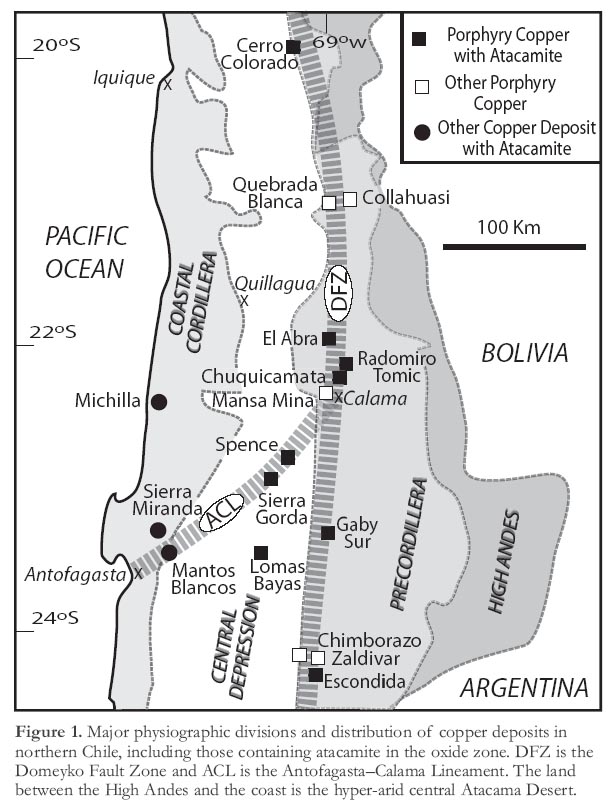
Display large image of Figure 1
3 The purpose of this paper is to provide an overview of the DPG Phase II research in northern Chile and subsequent investigations that grew out of that research. Deep Penetrating Geochemistry Phase I suggested that in a hyper-arid, tectonically active terrane such as northern Chile, movement of water by seismic activity should be a viable mechanism for the production of surficial geochemical anomalies (Cameron 1998). The northern Chile DPG Phase II research was designed to: i) collect soil samples over several areas of known mineralization and subject these samples to a variety of weak leaches, ii) collect groundwater samples, where possible, to determine the genetic link, if any, between soil geochemical anomalies and groundwater chemistry, and iii) use these data to interpret the process(es) of porphyry copper-associated metal migration, and more specifically to determine if seismic pumping was a viable mechanism for metal transfer. The DPG Phase II research indicated that, not only was seismic pumping a viable mechanism, but that it might also provide an alternative explanation for the formation of atacamite [Cu2Cl(OH)3], the most characteristic supergene oxide mineral of northern Chile. Therefore, further work was initiated to better constrain the origin and timing of formation of atacamite.
GEOLOGICAL AND HYDROLOGICAL BACKGROUND
4 The study area in northern Chile encompasses a large part of the Atacama Desert, the driest major desert on the planet (Fig. 1). Hyperaridity is pervasive throughout the Coastal Cordillera and Central Depression, changing to less arid conditions with increasing altitude and rainfall in the Precordillera. Rainfall minima occur near the boundary between the Central Depression and the Coastal Cordillera; at Quillagua (Fig. 1), the annual average rainfall is 0.5 mm. The Coastal Cordillera is a Carboniferous–Early Triassic magmatic arc that contains numerous copper deposits, of which the largest is the Early Cretaceous Mantos Blancos deposit (Ramirez et al. 2006; Oliveros et al. 2008). The basement of the Central Depression contains Jurassic and Cretaceous sedimentary–volcanic sequences, the former comprising rocks of both marine and non-marine origin, and including evaporites. From the late Oligocene through the middle Miocene, a large volume of sediment sourced from the Precordillera was deposited in the Central Depression, obscuring much of the basement; most prominent of these Tertiary sediments are early to middle Miocene piedmont gravels. The Precordillera consists of Triassic to Eocene fault-bounded blocks.
5 A Paleocene–early Eocene belt of porphyry copper deposits, including the Spence deposit, is situated within the Central Depression, and a late Eocene–early Oligocene belt is hosted by rocks of the Precordillera. These deposits are structurally controlled. In the Precordillera they occur along the Domeyko Fault Zone (DFZ), whereas the Spence deposit is spatially associated with the Antofagasta–Calama Lineament (ACL, Palacios et al. 2007; Fig. 1). During the structural and geomorphological evolution of the Precordillera, some deposits have been exhumed and exposed at the surface. Copper was extracted from Chuquicamata in pre-Inca times, and El Abra lies near the summit of a mountain. Conversely, some systems, such as Radomiro Tomic, Spence and Gaby Sur, are in structural depressions covered by thick gravels. Most exploration is now focused on methods of detecting deposits lying under this gravel cover.
Northern Chile
6 Since the early 1990s, most geochemical exploration programs in the Atacama Desert have employed selective leach analytical methods, designed to extract mobile element components that have migrated from deposits in solution. Proprietary selective leaches, such as Enzyme LeachSM and MMITM-A (Mobile Metal Ion, suite A (base metals)) have been used extensively in covered terrains. The Enzyme LeachSM method dissolves water-soluble salts plus loosely adsorbed metals, and allows determination of up to 50 elements by ICP-MS. The MMITM-A method measures four base metals, Cu, Zn, Cd and Pb, producing higher concentrations than Enzyme LeachSM because it uses an acidic extraction method to dissolve minerals, including carbonates.
Figure 2. Photograph of the ground surface directly above the Spence deposit, looking west. A gypcrete crust of non-pedogenic origin is near-ubiquitous in this area but has been removed by an unusual period of sheetflood erosion, revealing the bare piedmont gravel surface.
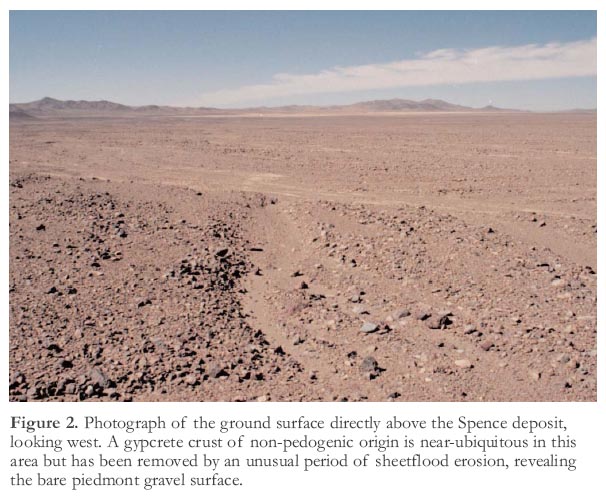
Display large image of Figure 2
7 Examination of data, acquired from soils overlying thick piedmont gravels above known deposits, provided the opportunity to evaluate the geo-chemical processes occurring within, and below, cover sequences. These data included soils collected at 200-m intervals over the Spence deposit, soon after its discovery by Rio Algom in 1997. The Spence deposit, covered by 50 to 100 m of gravel, was discovered by systematic grid drilling along favourable structural trends. The surface at Spence lacks the non-pedogenic gypcrete crust that is widespread throughout the Atacama Desert because it had been removed by sporadic sheet flood erosion. A lapilli tuff layer in gypcrete near Mantos Blancos was dated by the K–Ar (biotite) method at 2.97 ± 0.07 and 2.87 ± 0.03 Ma (Chavez 1985). If this timing is relevant to the Spence deposit, it provides a maximum age for the former erosional surface.
8 Initially, the coarse surface material (Fig. 2) provided little encouragement that geochemical studies would prove useful. Neither Enzyme LeachSM nor MMITM-A analyses from the 1997 soil survey revealed significant anomalies for Cu. Nevertheless, there were scattered Enzyme LeachSM anomalies for a suite of elements, principally Cl, I, Br and Mo. The presence of the three halogens suggested that saline groundwater had reached the surface.
Figure 3. Data for Mo analyzed by Enzyme LeachSM, from soil samples on two traverses across the Mansa Mina deposit, 4 km south of Chuquicamata, Chile. Data provided courtesy of Noranda Ltd. About 50 m of gravel overlies the deposit west of the West Fault, whereas up to several hundred metres of gravel cover lies east of the fault. On line B, data for sample #8 have been compared to the average of data from samples #1 to #3 (see text for details).
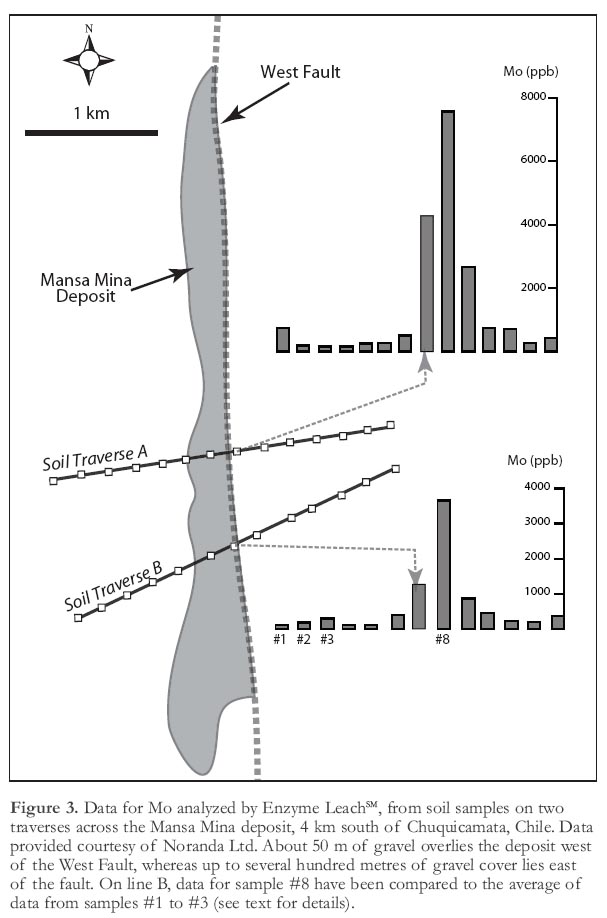
Display large image of Figure 3
9 Enzyme LeachSM data for soils above other deposits show anomalies for the same elements. These include surveys over the Fortuna de Cobre porphyry prospect adjacent to Lomas Bayas, and over the Radomiro Tomic deposit. Two soil geochemical traverses by Noranda over the Mansa Mina deposit provided the best clue to the origins of the Enzyme LeachSM anomalies. Mansa Mina (Sillitoe et al. 1996) is a faulted slice of porphyry mineralization, possibly from nearby Chuquicamata. The principal fault of the DFZ, the West Fault, forms its eastern boundary (Fig. 3). About 50 m of gravel overlie the deposit west of the fault, and gravel thickness increases to several hundred metres east of the fault. Samples from above, and immediately east of the fault, are strongly anomalous in several elements, including Mo (Fig. 3). Enrichment factors were determined for the most anomalous sample on Line B (Fig. 3) compared to average values of the most distal samples to the west; elements showing the highest ratios are Cl (64); Mo (19); Se (13); I (12); Br (9); and Cu (6). The location of the anomalies suggests that they are related to the fault.
EARTHQUAKE-INDUCED FORCING OF SALINE GROUNDWATER TO THE SURFACE
10 A scoping study by Cameron (1998) suggested a number of possible processes to explain the Cl, I, Br, and Mo soil geochemical anomalies. Vapour transport is not an option, because the principal constituent of the anomalies, NaCl, is non-volatile. Capillary transport of groundwater was also rejected as a significant mechanism for metal transport at the Spence deposit. Maximum depths for capillary rise are 0.15 m for coarse sand, 0.3 m for medium sand, 1 m for fine sand, and 1 to 10 m for silt (Jumikis 1967), whereas the depth to the water table at the Spence deposit is between 43 and 88 m. The most likely mechanism was identified as forcing of basement waters to the surface during earthquakes (Cameron et al. 2002). In inter-seismic periods, extension in basement rocks can cause cracks to open, drawing in water. During an earthquake, cracks close under compression, expelling water, which migrates to the faults and then to the surface (Muir-Wood 1994). Because of limited permeability in basement rocks, migration towards faults is slow; thus, unusual flows of waters in springs, streams and rivers persist for weeks or months after an earthquake. For example, in the desert areas of Iran, after earthquakes, surface soils have become waterlogged along fault lines (Tchalenko 1973; Tchalenko and Berberian 1974). Northern Chile is a region of high seismicity and, although the Atacama Desert does occasionally receive some rainfall, which can redistribute elements at the surface, the rate of erosion is mostly too low to disperse anomalies derived from seismic-related flooding once they have formed.
Figure 4. West–east section through the southern part of the Spence deposit at 7479000 N. Eastings are in metres. Porphyry is intruded into andesitic country rock both in the form of a large mass, as shown, and as dykes in the central of the three fracture zones (wavy broken lines). Modified from a section prepared by Rio Algom in 1999.
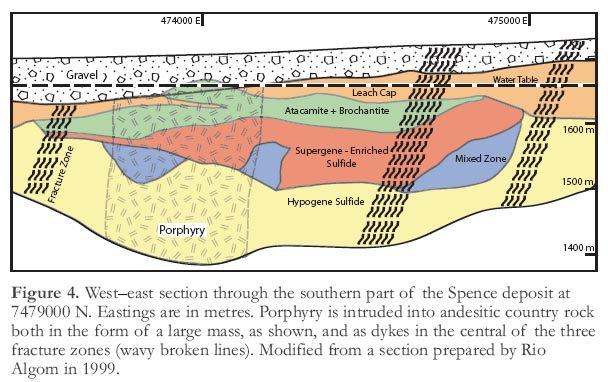
Display large image of Figure 4

Display large image of Figure 5
11 The Spence deposit was chosen to test the seismic pumping hypothesis. Porphyry intrusion and hypogene mineralization in andesite host rocks occurred along a north-northeast axis during the Paleocene. Dating of alunite shows that supergene alteration extended over a long period from 44 to at least 21 Ma (Rowland and Clark 2001). Copper minerals are atacamite and brochantite in the oxide zone; chalcocite, covellite, and pyrite in the enriched zone; and chalcopyrite, bornite, molybdenite, tennantite, and pyrite in the hypogene zone. Spence has reserves of 313 Mt grading 1.08% Cu and mining commenced in 2006. The topography of the deposit area controlled the variable thickness (50 to 100 m) of the gravel cover and the location of the water table, which is within the basal gravels to the north and within the oxide zone to the south (Fig. 4). The gravels are indurated and have a fine-grained matrix that renders them impermeable, except where fractured or where layers of better-sorted material occur near their base. South of the hypogene deposit, exotic copper oxide minerals are present in the basal gravels (Fig. 4), indicating that weathering-related lateral copper mobility continued after supergene oxidation and gravel deposition.
12 Groundwater, which was clear and contained no visible suspended phase, was sampled from drill holes in 1999 and 2000. Details of sampling, sample preparation, and analytical methods are given by Leybourne and Cameron (2006a). Fresh water flows into the deposit from the northeast and mixes with saline water found within and down-flow of the deposit (Fig. 5A). Data for F2H and F18O (Fig. 5B) help identify the source of the meteoric and saline waters. The more dilute meteoric waters plot close to the Global Meteoric Water Line (GMWL; Fig. 5B). Comparison of our Spence groundwater data with F18O data for precipitation in the Andes (Aravena et al. 1999), suggests that the meteoric waters come from elevations of 3500 m or greater in the Precordillera or the Andes (Cameron and Leybourne 2005); regional migration of high Andes recharge has been demonstrated elsewhere in the Atacama Desert using 14C dating of groundwater (Magaritz et al. 1990). The saline waters within and down-flow of the Spence deposit are interpreted to be formation (basinal brine) water flowing up from basement, presumably along fracture zones identified during drilling. Inflow of formation waters into the Spence deposit exceeds that of meteoric water, because saline water is dominant down-flow of the deposit.
Figure 6. Box and whisker plots for Br and I in Spence deposit groundwaters. For locations and classification of saline, meteoric and mixed waters, see Figure 5A.
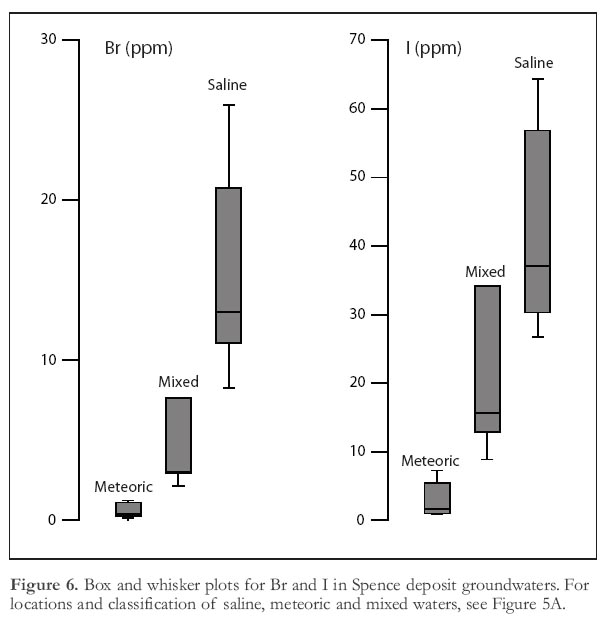
Display large image of Figure 6

Display large image of Figure 7
13 Many elements have substantially higher concentrations in Spence saline waters than in the meteoric waters (Leybourne and Cameron 2006a, 2008). Among those that show the greatest differences are Br, I (Fig. 6), Re, and Se. Bromine and iodine were earlier identified as major constituents of the anomalies developed in gravels above some copper porphyry deposits in northern Chile. The presence of these halogens is interpreted as evidence for generation of the anomalies by formation waters of deep, basement origin that have been pumped to the surface along faults or fracture zones.
14 At the Spence deposit, copper is enriched in all groundwater types, but is generally restricted to the deposit area (Fig. 7). Copper is not dispersed away from the deposit, because it is readily adsorbed to Fe-, Mn- and Aloxy-hydroxides, and may form secondary Cu minerals (Cameron and Ley-bourne 2005; Leybourne and Cameron 2008). A histogram of element ratios in filtered (< 0.45 m) vs. unfiltered water (Fig. 7) shows much higher concentrations of Al and Fe in the unfiltered samples, because these elements are present as colloidal Fe and Al oxyhydroxides. These oxy-hydroxides have a negative charge, which adsorbs cations such as Cu2+, and readily precipitate as coatings, fixing the Cu. In contrast, elements having filtered to unfiltered ratios near unity are not present in particulate form. These elements, Mo, S, Re, Br, I, and Se, dissolve in the weakly acidic to mildly alkaline groundwater as anions, which are not adsorbed by negatively charged oxy-hydroxides. Accordingly, Mo and other anions are dispersed in ground-water away from the deposit. Molybdenum is a ubiquitous minor constituent of copper porphyry mineralization. Because of its relatively high mobility under moderately oxidizing conditions (Stollenwerk 1995; Hodge et al. 1996), it is widespread in the groundwater of this region. For example, Mo has dispersed 65 km westward of the El Abra deposit to create intense Mo anomalies in soils within the Central Depression (Leybourne and Cameron 2006b).
Figure 8. Plots of Cu, Mo and Br, all by Enzyme LeachSM analysis, in a west–east soil traverse across the centre of the Spence deposit at 7480500 N. Soils were collected at depths of 10-20 cm.
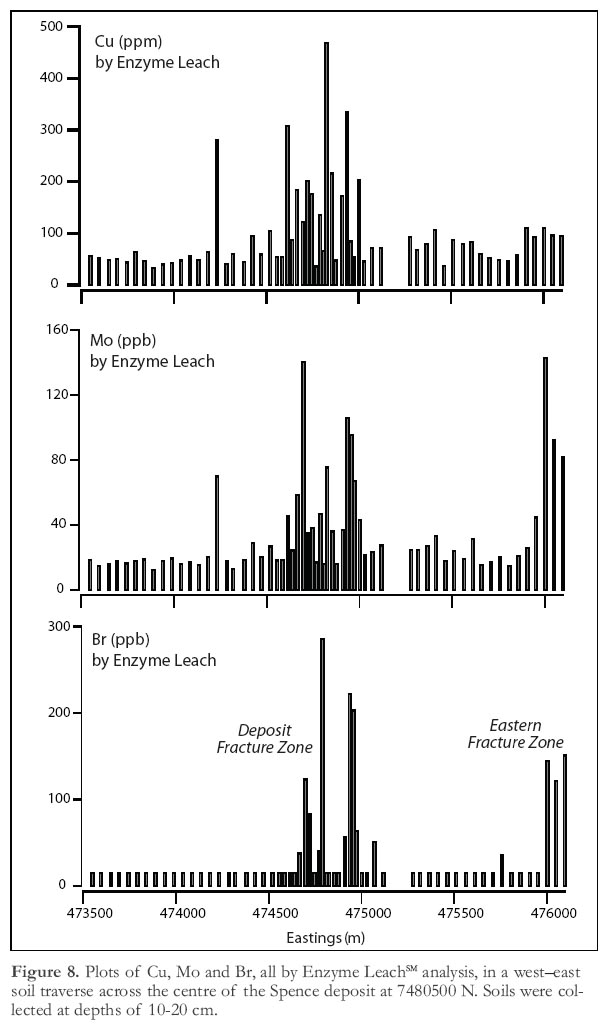
Display large image of Figure 8
15 Soil samples were collected on an east–west traverse across the Spence deposit (Fig. 7). Molybdenum and Br anomalies identify two locations where saline water of deep origin has reached the surface (Fig. 8), one directly over the deposit (Deposit Fracture Zone), and the other 1 km to the east (Eastern Fracture Zone). Trenching at these two locations showed the indurated gravels to be cut by vertical fractures, whereas a background location to the west of the deposit lacked fractures (Cameron et al. 2004); these fracture zones result from reactivation of basement faults. As saline waters were pumped to the surface during earthquakes, they carried dissolved and adsorbed Cu to the surface above the deposit, but this did not happen at the Eastern Fracture Zone, where drilling has shown the basement rocks to be barren. Molybdenum is anomalous above both fracture zones (Fig. 8). Given the mobility of Mo, this suggests that Mo-bearing mineralization is present up-gradient from these locations. Molybdenum and other mobile porphyry indicator elements thus provide a method of exploration using groundwater. This is possible because supergene-enriched porphyry deposits lie along the basement unconformity, above which the basal gravels, as at Spence, commonly represent an aquifer that can readily be sampled during mineral exploration.
Figure 9. Plot of Cu and Se in soil profiles directly over the Spence deposit and at a background site west of the deposit. All analyses were performed by Enzyme LeachSM.
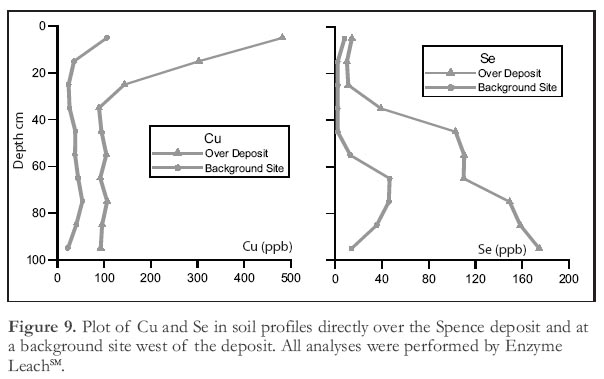
Display large image of Figure 9
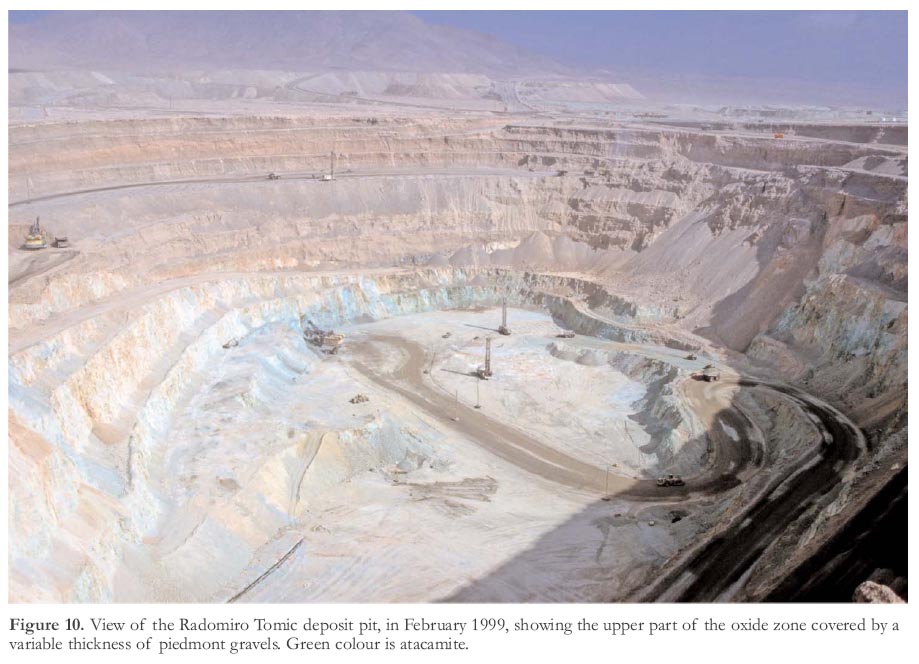
Display large image of Figure 10
16 After reaching the surface, elements transported by mineralized groundwater are redistributed by the occasional rains and subsequent surface flow. Mimicking their behaviour in groundwater, elements dissolving as anions, such as Se, are moved to depth (Fig. 9), whereas cations, including Cu, are retained near the surface by adsorption on oxide coatings. By normal soil processes, Cu is then incorporated into different minerals, notably carbonate (Cameron et al. 2004). Part of the objective of the CAMIRO program was to compare the effectiveness of different selective leaches by measuring the anomaly-to-background contrast for each leach. In Chile, at the Spence, Gaby Sur and Mansa Mina deposits, all soil samples were analyzed using up to five selective leaches plus an aqua regia leach. Whereas the Enzyme LeachSM (equivalent to a water-soluble metals leach) yields large anomalies over Spence, leaches that dissolve the carbonate minerals, such as ammonium acetate and MMITM-A, provide greater anomaly contrast (Cameron et al. 2004). The profile for Cu (Fig. 9) reveals why samples collected in 1997 were not anomalous for Cu over Spence: they were sampled at a depth of ca. 40 cm, whereas sampling depth in 1999 was 10 to 20 cm.
FORMATION OF ATACAMITE
17 Supergene enrichment of porphyry copper deposits in the Atacama Desert occurred before the climate became hyper-arid. Supergene enrichment by meteoric waters therefore occurred over an extended period, starting around 44 Ma. Estimates of termination of supergene processes vary from mid Miocene (11–14 Ma; Alpers and Brimhall 1989; Sillitoe and McKee 1996; Mote et al. 2001) to as recently as the early Pliocene (3–5 Ma; Hartley and Rice 2005; Arancibia et al. 2006). It has been assumed that supergene oxide assemblages that formed prior to the onset of hyperaridity have been preserved since that time. However, a corollary of our hypothesis of seismic pumping of groundwater to surface through mineralized rock is that water-deposit interaction, and resultant supergene and exotic mineralization processes, may not have ceased.
18 Passage of saline formation waters through an oxide zone, as at Spence, would have caused these assemblages to change. Cupric hydroxy assemblages re-equilibrate rapidly within days or weeks when solution compositions change (Woods and Garrels 1986). Northern Chile is unique in having atacamite [Cu2Cl(OH)3], which requires Cl-rich saline water for its formation, as a component of the oxide zone of many porphyry copper and other copper deposit types (Fig. 1). Aside from northern Chile, its most characteristic occurrence is on the sea floor, where it forms as a product of weathering of copper sulfides (Hannington 1993). Elsewhere, because it is rapidly dissolved or replaced by other copper minerals when it is exposed to meteoric water, atacamite is rare. Mac-Farlane et al. (2005) passed a slow flow of water through powdered atacamite-bearing ore and found that all Cl and most of the Cu was removed in less than an hour.
19 A photograph of the open pit at Radomiro Tomic (Fig. 10), taken in 1999 when the upper part of the oxide zone was being mined, shows the characteristic emerald green of atacamite, the most abundant copper mineral of the oxide zone (Cuadra and Rojas 2001). The deposit forms a basement hill covered by piedmont gravels, which vary in thickness from 30 m to 150 m. A tuff near the top of the gravels was dated at 9.7 ± 0.7 Ma by K–Ar (biotite) (Cuadra et al. 1997). When the photograph (Fig. 10) was taken, the water table was near the base of the pit. Below this, meteoric water flows across the deposit, ‘floating’ on deeper, denser, saline water (Cameron et al. 2007). In a zone 50 m below the water table, atacamite has been removed, and replaced by other copper minerals (Cuadra and Rojas 2001).
20 Atacamite has been considered to be a primary product of super-gene oxidation, both generally in the region (Chavez 2000), and specifically for this deposit (Arcuri and Brimhall 2003). However, during the long period of supergene oxidation, at least episodic rainfall must have fallen; Clark et al. (1990) suggest >10 cm/year, compared to the present <10 mm/year. Under these conditions, any atacamite that may have periodically formed would have been removed by percolating meteoric water during episodes of rainfall. Hence, in contrast to a primary supergene origin for the atacamite, Cameron et al. (2007) proposed that supergene copper oxide minerals were later replaced by atacamite following the onset of hyper-arid climatic conditions. Equilibrium diagrams show that atacamite is stable in saline waters at Spence (Leybourne and Cameron 2008), and an antipathetic relationship between SO4 and Cl in these waters suggest that brochantite is currently being replaced by atacamite (Cameron et al. 2007). At Radomiro Tomic and Spence, atacamite has been deposited in the basal gravels. In addition, there are Cl–Br–I anomalies in soils above both deposits, indicating that saline waters have reached the surface. Hyperaridity is required for the formation and preservation of super-gene atacamite; it is preserved above the water table at Radomiro Tomic because there is no recharge through the vadose zone. At Spence, when a wetter climate prevailed, there would have been a greater inflow of meteoric waters through the oxide zone. When these wet conditions ended and a hyper-arid climate began is much debated. It was previously thought to have followed the main period of supergene enrichment that ended at 14 Ma, but recent dating of post-14 Ma supergene events, along with other evidence (Hartley and Rice 2005; Arancibia et al. 2006), suggest that hyperaridity started at around 4 Ma. In the case of the Radomiro Tomic deposit, the onset of hyperaridity must have been later than the 9.7 Ma date for the gravels.
21 Reich et al. (2008), using samples from Spence and Mantos Blancos, demonstrated that the salinity of fluid inclusions in atacamite overlaps that of the local groundwater (Fig. 11), which is what one would expect if atacamite forms through the interaction of saline groundwater and pre-existing copper oxides. This comparison is given greater significance by the substantially different groundwater salinity at the two locations. At Spence, the saline waters are flowing through the oxide zone, whereas at Mantos Blancos they are at much greater (400 m) depth. This implies that saline waters could only have contacted the pre-existing oxide minerals by being episodically forced to the surface, i.e. by seismic activity.
22 Palacios et al. (2005) showed that Cu-bearing saline waters have reached the surface around Mantos Blancos, where rocks are well exposed, not covered by gravels. ‘Spike’ Cu anomalies up to 1200 ppm, and correlated anomalies for Na on hills and slopes 250 to 300 m above known mineralization, contrast with background concentrations over barren rocks and correspond to the surface projection of known faults that intersect mineralization at depth. Palacios et al. (2005) also report salt efflorescences at the surface along major faults; in places, these efflorescences have a green colouration that was shown (by X-ray diffraction) to be related to the presence of atacamite and chalcantite. The distribution of these copper minerals locally extends several hundreds of metres, depending on the importance of the faults and the size of the mineralized bodies. The internal texture and structures within the efflorescences suggest explosion bubbles, which could indicate that a mixture of liquid plus air or gas has reached the surface.
Figure 11. Box and whisker plots comparing the salinity of fluid inclusions in atacamite with that of local groundwater in the vicinity of the Mantos Blancos and Spence deposits. The salinity of fluid inclusions at Spence (n = 43), fluid inclusions at Mantos Blancos (n = 48) and groundwaters from Mantos Blancos (n = 32) are from Reich et al (2008). The salinity of groundwaters at Spence are for the saline waters (n = 13) shown in Figure 5A.

Display large image of Figure 11
23 If atacamite forms by seismic pumping of saline groundwater to surface, the implication is that this mineral may be young, potentially much younger than other supergene copper minerals in the oxide zones of copper deposits in the Atacama Desert. It is therefore significant that new U–Th disequilibrium data for gypsum-atacamite intergrowths from several deposits in northern Chile indicate formation ages of ~ 240 ka to as young as ~ 80 ka (Reich et al. 2009).
CONCLUSIONS
24 Although use of weak partial leaches of soils is common in mineral exploration, a lack of understanding of the processes by which surface anomalies form from deeply buried mineralization has hampered effective utilization of exploration geochemical data. This study around the copper deposits in northern Chile, over the last ten years, has shown that groundwater sampled in, and around, the Spence porphyry copper deposit has a geochemical signature similar to soil geochemical anomalies overlying mineralization at the deposit. The trace metal, metalloid, and isotopic geochemistry of the groundwater clearly demonstrates water-deposit interaction. The genetic link between the soil anomalies and groundwater supports the hypothesis that surface geochemical anomalies are generated by movement of water to surface during seismic events. The hyper-arid climate of northern Chile is conducive to preservation of these geochemical anomalies directly over mineralization. Groundwater at the Spence deposit is saline within and down-flow of the deposit, and is geo-chemically and isotopically similar to formation waters recovered from sedimentary basins elsewhere. This finding led to the hypothesis that one of the main supergene copper minerals, atacamite, may not be the product of Miocene to Pliocene supergene enrichment processes, but could be better explained as a later replacement of earlier supergene copper minerals. The saline groundwater at the Spence and Mantos Blancos deposits is at or near saturation with respect to atacamite. An origin for atacamite that links it to seismically pumped saline groundwater is consistent with our fluid inclusion studies of atacamite from several deposits in northern Chile, and with U–Th disequilibrium age dating of gypsum intergrown with fracture-zone atacamite. These studies have important implications for geochemical exploration, supergene mineralization models, and interpretations of climate change in northern Chile.
ACKNOWLEDGEMENTS
For the initial studies in Chile, EMC thanks Garth Graves of Noranda, Roger Nordin of Boliden, and Bob Clark of Actlabs. The CAMIRO study was made possible by the support, encouragement and advice of 28 company sponsors, including commercial laboratories, who provided the analyses. Many of the sponsors travelled long distances to attend meetings. We were fortunate to have the guidance of three successive directors of the Exploration Division of CAMIRO, Ed Debicki, Richard Alcock and Tom Lane. In Chile we received generous assistance from George Steele of Rio Tinto, Ollie Bonham and Jack Currie of RioChilex, and Alvaro Puig of Codelco. Daniel Salinas of Rio Tinto and Alexi Ramirez of RioChilex worked with us in the field. We thank them for their energy and skill and for their sense of humour. Finally, our colleagues in the Canadian phase of the study, Stew Hamilton, Gwendy Hall and Beth McClenaghan, all contributed to making this a rewarding and pleasant project. Bill Chávez and Brian Townley provided thorough reviews for which we are very grateful. We also thank Associate Editor Dave Lentz for constructive comments on the manuscript.REFERENCES
Alpers, C.N., and Brimhall, G.H., 1989, Paleohydrologic evolution and geo-chemical dynamics of cumulative supergene metal enrichment at La Escondida, Atacama Desert, Northern Chile: Economic Geology, v. 84, p. 229-255.
Arancibia, G., Matthews, S.J., and De Arce, C.P., 2006, K-Ar and 40Ar/39Ar geochronology of supergene processes in the Atacama Desert, Northern Chile: Tectonic and climatic relations: Journal of the Geological Society, London, v. 163, p. 107-118.
Aravena, R., Suzuki, O., Pena, H., Pollastri, A., Fuenzalida, H., and Grilli, A., 1999, Isotopic composition and origin of the precipitation in northern Chile: Applied Geochemistry, v. 14, p. 411-422.
Arcuri, T., and Brimhall, G., 2003, The chloride source for atacamite mineralization at the Radomiro Tomic porphyry copper deposit, Northern Chile: Economic Geology, v. 98, p. 1667-1681.
Cameron, E.M., 1998, Deep-Penetrating Geochemistry: Unpublished Report of the Canadian Mining Industry Research Organization (CAMIRO), 177 p.
Cameron, E.M., and Leybourne, M.I., 2005, Relationship between groundwater chemistry and soil geochemical anomalies at the Spence copper porphyry deposit, Chile: Geochemistry: Exploration, Environment, Analysis, v. 5, p. 135-145.
Cameron, E.M., Leybourne, M.I., and Kelley, D.L., 2002, Exploring for deeply covered mineral deposits: Formation of geochemical anomalies in northern Chile by earthquake-induced surface flooding of mineralized groundwaters: Geology, v. 30, p. 1007-1010.
Cameron, E.M., Leybourne, M.I., and Kelley, D.L., 2005, Exploring for deposits under deep cover using geochemistry: Society of Economic Geologists Newsletter no. 63, p. 5-15.
Cameron, E.M., Leybourne, M.I., and Palacios, C., 2007, Atacamite in the oxide zone of copper deposits in northern Chile: Involvement of deep formation waters?: Mineralium Deposita, v. 42, p. 205-218.
Cameron, E.M., Hamilton, S.M., Ley-bourne, M.I., Hall, G.E.M., and McClenaghan, B., 2004, Finding deeply-buried deposits using geo-chemistry: Geochemistry: Exploration, Environment, Analysis, v. 4, p. 7-32.
Chávez, W.X., 2000, Supergene oxidation of copper deposits: Zoning and distribution of copper oxide minerals: Society of Economic Geologists Newsletter, v. 41, p. 1-21.
Chávez, W.X., Jr., 1985, Geologic setting and the nature and distribution of disseminated copper mineralization of the Mantos Blancos District, Antofagasta Province, Chile: Unpublished Ph.D. thesis, University of California at Berkeley, 187 p.
Clark, A.H., Tosdal, R.M., Farrar, E., Plazolles V, A., and Skinner, B.J., 1990, Geomorphologic environment and age of supergene enrichment of the Cuajone, Quellaveco, and Toquepala porphyry copper deposits, southeastern Peru: Economic Geology, v. 85, p. 1604-1628.
Cuadra, C.C., and Rojas, G.S., 2001, Oxide mineralization at the Radomiro Tomic porphyry copper deposit, northern Chile: Economic Geology, v. 96, p. 387-400.
Cuadra, C.P., Zentilli, M., Puig, A., and Tidy, E., 1997, Dataciones radiometricas recientes en Radomiro Tomic: Proceedings, 8th Chilean Geological Congress, p. 916-919.
Hall, G.E.M., Vaive, J.E., Beer, R., and Hoashi, M., 1996, Selective leaches revisited, with emphasis on the amorphous Fe oxyhydroxide phase extraction: Journal of Geochemical Exploration, v. 56, p. 59-78.
Hamilton, S.M., 1999, Transport mechanisms responsible for selective leach anomalies, in Geoanalysis with Emphasis on Selective Extractions: Association of Exploration Geo-chemists, Short Course Proceedings, 19th International Geochemical Exploration Symposium, Vancouver.
Hamilton, S.M., Cameron, E.M., McClenaghan, M.B., and Hall, G.E.M., 2004a, Redox, pH and SP variation over mineralization in thick glacial overburden; Part I, Methodologies and field investigation at the Marsh Zone gold property: Geochemistry: Exploration, Environment, Analysis, v. 4, p. 33-44.
Hamilton, S.M., Cameron, E.M., McClenaghan, M.B., and Hall, G.E.M., 2004b, Redox, pH and SP variation over mineralization in thick glacial overburden; Part II, Field investigation at Cross Lake VMS property: Geo-chemistry: Exploration, Environment, Analysis, v. 4, p. 45-58.
Hannington, M.D., 1993, The formation of atacamite during weathering of sulfides on the modern seafloor: Canadian Mineralogist, v. 31, p. 945-956.
Hartley, A.J., and Rice, C.M., 2005, Controls on supergene enrichment of porphyry copper deposits in the central Andes: A review and discussion: Mineralium Deposita, v. 40, p. 515-525.
Hodge, V.F., Johannesson, K.H., and Stetzenbach, K.J., 1996, Rhenium, molybdenum, and uranium in groundwater from the southern Great Basin, USA: Evidence for conservative behaviour: Geochimica et Cosmochimica Acta, v. 60, p. 3197-3214.
Jumikis, A.R., 1967, Introduction to Soil Mechanics. D. van Norstrand Co, Princeton, NJ, 436 p.
Leybourne, M.I., and Cameron, E.M., 2006a, Composition of groundwaters associated with porphyry-Cu deposits, Atacama Desert, Chile: Elemental and isotopic constraints on water sources and water-rock reactions: Geochimica et Cosmochimica Acta, v. 70, p. 1616-1635.
Leybourne, M.I., and Cameron, E.M., 2006b, Composition of soils and groundwaters at the Pampa del Tamarugal, Chile: Anatomy of a fossil geochemical anomaly derived from a distant porphyry copper deposit: Economic Geology, v. 101, p. 1569-1581.
Leybourne, M.I., and Cameron, E.M., 2008, Source, transport, and fate of rhenium, selenium, molybdenum, arsenic, and copper in groundwater associated with porphyry-Cu deposits, Atacama Desert, Chile: Chemical Geology, v. 247, p. 208-228.
MacFarlane, W.R., Kyser, T.K., Chipley, D., Beauchemin, D., and Oates, C., 2005, Continuous leach inductively coupled plasma mass spectrometry: Applications for exploration and environmental geochemistry: Geochemistry: Exploration, Environment, Analysis, v. 5, p. 123-134.
Magaritz, M., Aravena, R., Peña, H., Suzuki, O., and Grilli, A., 1990, Source of ground water in the deserts of northern Chile: Evidence of deep circulation of ground water from the Andes: Ground Water, v. 28, p. 513-517.
Mote, T.I., Becker, T.A., Renne, P., and Brimhall, G.H., 2001, Chronology of exotic mineralization at El Salvador, Chile, by 40Ar/39Ar dating of copper wad and supergene alunite: Economic Geology, v. 96, p. 351-366.
Muir-Wood, R., 1994, Earthquakes, strain cycling and the mobilization of fluids, in Parnell, J., ed., Geofluids: Origin, Migration and Evolution of Fluids in Sedimentary Basins, Geological Society of London, Special Publication 78, pp. 85-98.
Oliveros, V., Feraud, G., Aguirre, L., Ramirez, L., Fornari, M., Palacios, C., and Parada, M., 2008, Detailed 40Ar/39Ar dating of geologic events associated with the Mantos Blancos copper deposit, northern Chile: Mineralium Deposita, v. 43, p. 281-293.
Palacios, C., Guerra, N., Townley, B., Lahsen, A., and Parada, M.A., 2005, Copper geochemistry in salt from evaporite soils, Coastal Range of the Atacama Desert, northern Chile: An exploration tool for blind copper deposits: Geochemistry: Exploration, Environment, Analysis, v. 5, p. 371-378.
Palacios, C., Ramírez, L.E., Townley, B., Solari, M., and Guerra, N., 2007, The role of the Antofagasta — Calama Lineament in ore deposit formation in the Andes of northern Chile: Mineral-ium Deposita, v. 42, p. 301-308.
Ramirez, L.E., Palacios, C., Townley, B., Parada, M.A., Sial, A.N., Fernandez-Turiel, J.L., Gimeno, D., Garcia-Valles, M., and Lehmann, B., 2006, The Mantos Blancos copper deposit, an Upper Jurassic breccia-style hydrothermal system in the Coastal Range of northern Chile: Mineralium Deposita, v. 41, p. 246-258.
Reich, M., Palacios, C., Parada, M.A., Fehn, U., Cameron, E.M., Leybourne, M.I., and Zúñiga, A., 2008, Atacamite formation by deep saline waters in copper deposits from the Atacama Desert, Chile: Evidence from fluid inclusions, groundwater geochemistry, TEM, and 36Cl data: Mineralium Deposita, v. 43, p. 663-675.
Reich, M., Palacios, C., Vargas, G., Luo, S., Cameron, E.M., Leybourne, M.I., Parada, M.A., and Zuñiga, A., 2009, Supergene enrichment of copper deposits since the onset of modern hyperaridity in the Atacama Desert, Chile: Mineralium Deposita, v. 44, DOI: 10.1007/s00126-009-0229-3.
Rowland, M.D., and Clark, A.H., 2001, Temporal overlap of supergene alteration and high-sulphidation mineralization in the Spence porphyry copper deposit, II Region, Chile: Geological Society of America Annual Meeting, Boston, Paper No. 150-0.
Sillitoe, R., and McKee, E., 1996, Age of supergene oxidation and enrichment in the Chilean Porphyry Copper Province: Economic Geology, v. 91, p. 164-179.
Sillitoe, R.H., Marquardt, J.C., Ramirez, F., Becerra, H., Gomez, M., Camus, F., Sillitoe, R.M., and Petersen, R., 1996, Geology of the concealed MM porphyry copper deposit, Chuquicamata District, northern Chile, in Camus, F., Sillitoe, R.H., and Petersen, R., eds., Andean Ccopper Deposits: New Discoveries, Mineralization, Styles and Metallogeny: Society of Economic Geologists Special Publication 5, p. 59-70.
Stollenwerk, K.G., 1995, Modeling the effects of variable groundwater chemistry on adsorption of molybdate: Water Resources Research, v. 31, p. 347-358.
Taylor, H.P., Jr., 1974, The application of oxygen and hydrogen isotope studies to problems of hydrothermal alteration and ore deposition: Economic Geology, v. 69, p. 843-883.
Tchalenko, J.S., 1973, The Kashmar (Turshiz) 1903 and Torbat-e Heidariyeh (South) 1923 earthquakes in Central Khorassan (Iran): Annali di Geofisica, v. 26, p. 29-40.
Tchalenko, J.S., and Berberian, M., 1974, The Salmas earthquake of May 6th, 1930: Annali di Geofisica, v. 27, p. 151-212.
Woods, T.L., and Garrels, R.M., 1986, Phase relations in some cupric hydroxyl minerals: Economic Geology, v. 81, p. 1989-2007.